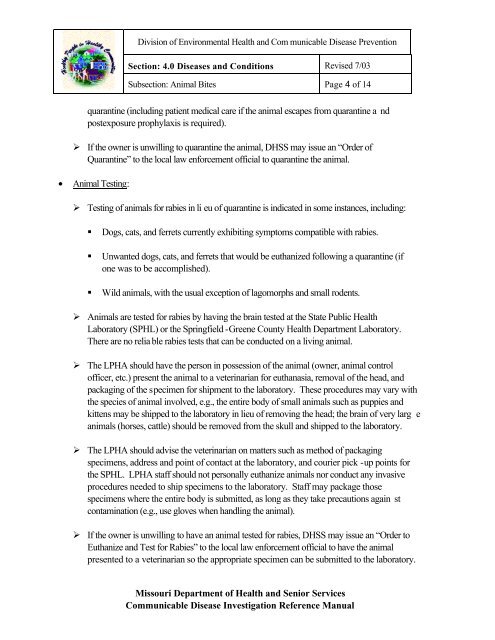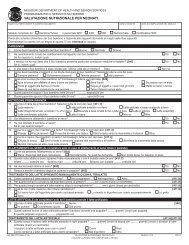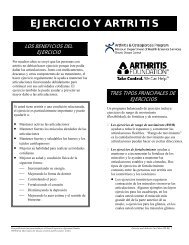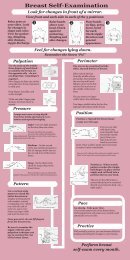Animal Bites / Injuries - Missouri Department of Health & Senior ...
Animal Bites / Injuries - Missouri Department of Health & Senior ...
Animal Bites / Injuries - Missouri Department of Health & Senior ...
Create successful ePaper yourself
Turn your PDF publications into a flip-book with our unique Google optimized e-Paper software.
Division <strong>of</strong> Environmental <strong>Health</strong> and Com municable Disease Prevention<br />
Section: 4.0 Diseases and Conditions Revised 7/03<br />
Subsection: <strong>Animal</strong> <strong>Bites</strong> Page 4 <strong>of</strong> 14<br />
quarantine (including patient medical care if the animal escapes from quarantine a nd<br />
postexposure prophylaxis is required).<br />
‣ If the owner is unwilling to quarantine the animal, DHSS may issue an “Order <strong>of</strong><br />
Quarantine” to the local law enforcement <strong>of</strong>ficial to quarantine the animal.<br />
• <strong>Animal</strong> Testing:<br />
‣ Testing <strong>of</strong> animals for rabies in li eu <strong>of</strong> quarantine is indicated in some instances, including:<br />
• Dogs, cats, and ferrets currently exhibiting symptoms compatible with rabies.<br />
• Unwanted dogs, cats, and ferrets that would be euthanized following a quarantine (if<br />
one was to be accomplished).<br />
• Wild animals, with the usual exception <strong>of</strong> lagomorphs and small rodents.<br />
‣ <strong>Animal</strong>s are tested for rabies by having the brain tested at the State Public <strong>Health</strong><br />
Laboratory (SPHL) or the Springfield -Greene County <strong>Health</strong> <strong>Department</strong> Laboratory.<br />
There are no relia ble rabies tests that can be conducted on a living animal.<br />
‣ The LPHA should have the person in possession <strong>of</strong> the animal (owner, animal control<br />
<strong>of</strong>ficer, etc.) present the animal to a veterinarian for euthanasia, removal <strong>of</strong> the head, and<br />
packaging <strong>of</strong> the specimen for shipment to the laboratory. These procedures may vary with<br />
the species <strong>of</strong> animal involved, e.g., the entire body <strong>of</strong> small animals such as puppies and<br />
kittens may be shipped to the laboratory in lieu <strong>of</strong> removing the head; the brain <strong>of</strong> very larg e<br />
animals (horses, cattle) should be removed from the skull and shipped to the laboratory.<br />
‣ The LPHA should advise the veterinarian on matters such as method <strong>of</strong> packaging<br />
specimens, address and point <strong>of</strong> contact at the laboratory, and courier pick -up points for<br />
the SPHL. LPHA staff should not personally euthanize animals nor conduct any invasive<br />
procedures needed to ship specimens to the laboratory. Staff may package those<br />
specimens where the entire body is submitted, as long as they take precautions again st<br />
contamination (e.g., use gloves when handling the animal).<br />
‣ If the owner is unwilling to have an animal tested for rabies, DHSS may issue an “Order to<br />
Euthanize and Test for Rabies” to the local law enforcement <strong>of</strong>ficial to have the animal<br />
presented to a veterinarian so the appropriate specimen can be submitted to the laboratory.<br />
<strong>Missouri</strong> <strong>Department</strong> <strong>of</strong> <strong>Health</strong> and <strong>Senior</strong> Services<br />
Communicable Disease Investigation Reference Manual
















